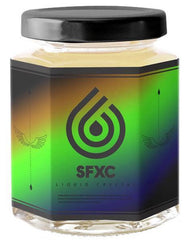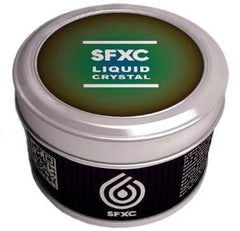What is Liquid Crystal?
Well, this smart material is certainly beautiful; and a firm favourite at SFXC HQ. As a living protein, it is very sensitive to temperature changes. It is neither liquid nor solid, with the ability to transition through several states. Before heat is applied, Liquid Crystal is cloudy in colour. But once it has reached its activation temperature, it magically transforms through a rainbow of vibrant colours like blue, red and green. Each colour indicates a temperature within a range of +/- 0.5 degrees or less.
The two most common types of Thermochromic Liquid Crystal (TLC):
Cholesteric; derived from esters of cholesterol
Chiral Nematic; derived from non sterol chemicals
Liquid Crystal has a Chiral (twisted) molecular structure. The layers are arranged like that of a solid in very organised, parallel layers. Yet at the same time, LC has the flowing properties of a liquid.
During manufacturing, Liquid Crystalline must be protected by microencapsulation, which helps to maintain its Thermochromic properties. These capsules are mixed with polymers and other substances to create a stable and incredibly versatile product. This process produces an 'aqueous slurry'. As such, any carrier fluids used with TLCs must be aqueous. Essentially, TLCs are oils with a consistency between a thick paste and an oil.
 The result is a gradient of shades of red, green then blue between 24°C and 29°C. Depending how white light is reflected will change what colours are visible. Brighter light means the colour will be more intense. When the temperature is below or above its activation level, it will appear colourless.
The result is a gradient of shades of red, green then blue between 24°C and 29°C. Depending how white light is reflected will change what colours are visible. Brighter light means the colour will be more intense. When the temperature is below or above its activation level, it will appear colourless.
For a dramatic effect, a black background is your best bet. Either matt or shiny surfaces work; Liquid Crystal will stand out either way. Multiple layers will ensure greater colour intensity.
You are probably familiar with LCD, or Liquid Crystal Display, the standard display in nearly every electronic device: Computers...TVs…even digital watches incorporate this technology. For application, Liquid Crystal has numerous creative and commercial uses: Thermometer strips, batteries and thermal mapping are just a few goods which utilise this marvellous material. The medical industry uses LC thermometers for monitoring patient's temperatures.
At SFXC, we stock 3 different types of Liquid Crystal products:
An ink: best applied via screen printing
A sprayable coating
Vinyl sheets which can be easily cut
Andy O'Rourke used our Liquid Crystal sheets to design his Snow Dog.
This clever material is the quintessential tool for scientific education in schools and universities. If you are an educator looking to use this inspirational product with students, we offer Small and Large demonstration packs which include this inspirational material.
As screen printing can be used on such a versatile array of materials, LC can also be applied to fabrics and other textile items.
SFXC Sprayable Liquid Crystal Ink has a coverage up to 35ml per sqm. Our preferred method of application is using an airbrush. We stock an Electric Paint Sprayer (900ml capacity) and a small Spray Booth.
A TLC coating can be removed with acetone or a solvent. If grease or organic solvents come into contact with the LC, the resulting colours can be affected.
 Liquid Crystal is sure to enchant makers, creators and innovators, for many generations to come.
Liquid Crystal is sure to enchant makers, creators and innovators, for many generations to come.
What experiments or inventions would you like to try with Liquid Crystal? Let us know in the comments below or reach out to us on social media!

